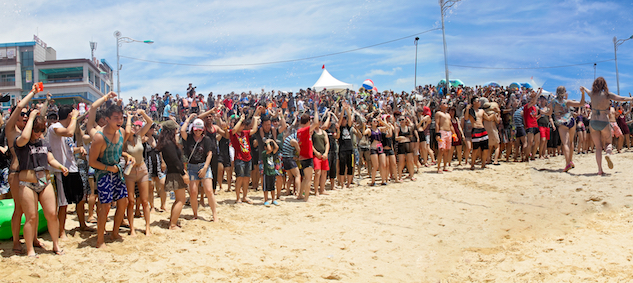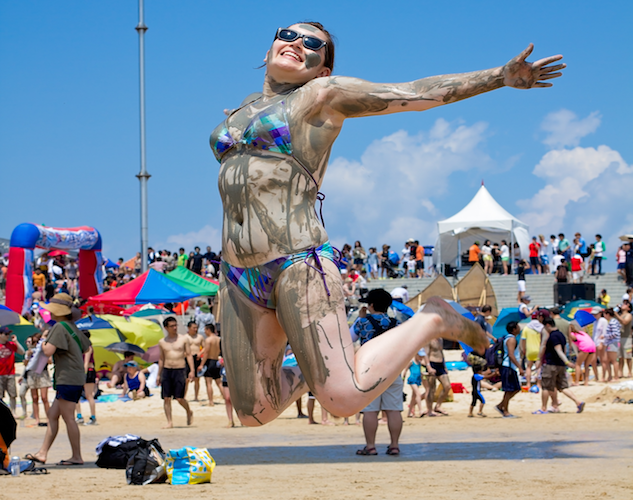Your Guide to Korea’s Boryeong Mud Festival
Photos by Paige Stewart
South Korea is adept at finding reasons to celebrate. Their selection of festivals ranges from the freezing—the Hwacheon Ice Festival—to the entomological—the Muju Firefly Festival—to the fiery—the Goesan Red Pepper Festival—to the insane—the Cheongdo Bullfighting Festival. Every weekend, you can find a mass celebration somewhere in the country.
But when it comes to international attendance, spending, and debauchery, none rival the Boryeong Mud Festival. According to the Korea Tourism Organization, it is the Boryeong Mud Festival—or Mudfest, as its colloquially called—that brings in more foreign bodies to the country than any other event.
In a yearly July migration that could rival Chinese New Year, thousands of Korea residents migrate to Boryeong, on the west coast of the peninsula, to attend Mudfest, which occurs mainly along the clear waters of Boryeong’s Daecheon Beach. More fly in from neighboring countries, and tourists from as far off as Europe and America plan their visits to Korea around it. Normally a quiet and placid beachside town, Boryeong is transformed into Northeast Asia’s premiere shit show one weekend a year.
It didn’t begin this way. The festival was created in 1999 to promote cosmetics made from Boryeong mud. According to the organizers, Boryeong mud is high in minerals—particularly germanium and bentonite—and it radiates infrared rays, which are great for the skin.
But it wasn’t long before the marketing of mudpacks took second place to the enormous party that occurs in tandem on the beach.
What to Expect

It begins in the morning, when busloads of tourists arrive and head straight to the beach, which will be prepped full of mud (much of it trucked in). Separate sections—some with admission fees, some without—are set up and filled with mud slides, mud pits, a mud prison, giant mud baths, a children’s area, mud fountains, and a mud swimming pool. The point is to get as muddy as possible, so that by the end, everyone looks like an extra in a monster movie.
Moon Sunyoung is a tour guide who took two busloads of foreigners to Mudfest in 2013 and 2014. “Getting muddy in a bikini isn’t something you get to do every day,” she says. “You get soaked with mud, jump into the ocean, get muddy again, get your friends muddy, get strangers muddy, and drink a lot of beer.”
Like it is in Korean daily living, drinking is a big part of Mudfest, even though city officials prefer it weren’t. “Many people drink a lot ‘til the morning,” says Haillie Lee, an official at Boryeong City Hall. “We don’t want them to drink on the beach; and they leave their trash—some even throw bottles on the street. It is very dangerous.”
Haillie says trouble has happened in the past, but she refused to be specific. Probably because, as she says, the festival and its spin-offs also bring in over $40 million a year and create plenty of jobs. So it’s worth it for them to keep it going, despite the mess it leaves behind.
Expat Allison Lee (no relation to Haillie), from Portland, Oregon had a typical experience when she went to Mudfest with Moon.
-

-

-

-

- Curated Home Page Articles By Test Admin October 21, 2025 | 3:10pm
-

- Curated Home Page Articles By Test Admin October 21, 2025 | 2:57pm
- Urls By Test Admin October 21, 2025 | 2:57pm
- Curated Home Page Articles By Test Admin October 21, 2025 | 2:55pm
-

-

-

-

-

-

-

-

-

-

-

-

-

-

-

-

-

-

-

-

-

-

-

-

-

-

-

-

-

-

-





































